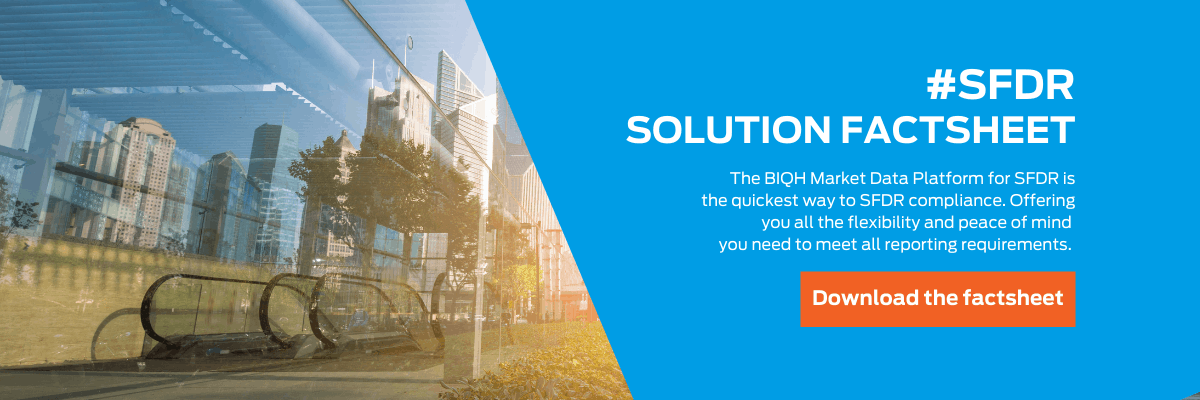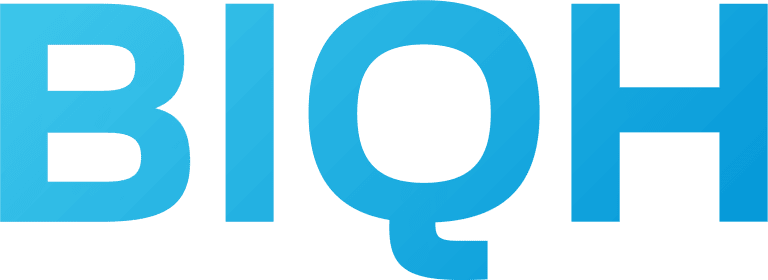A full overview of the most important definitions and stakeholders in SFDR
As of March 2021 the new Sustainable Finance Disclosure Regulation [SFDR] came into effect. This regulation is developed to drive sustainable investment. The SFDR will have big impact on asset managers, banks and fund brokers. In the upcoming weeks we will publish a blog series focusing on the SFDR, the obligations, the timelines, the definitions and the Adverse Sustainable Impacts Statement to help you get your head around the subject. And to ensure you are well prepared for the new regulation.
In our previous blog posts on SFDR we gave you a brief introduction to this upcoming regulation and on the timeliness and progress of implementation. In this third blog post we’ll focus on the most relevant definitions used within and the most important stakeholders affected by this regulation. We created this handy and complete SFDR glossary for your reference.
This blog post was first published on November 11, 2020 and updated on May 6, 2021.
Most important definitions and stakeholders in the SFDR
In this blog post we created a SFDR glossary with all the important SFDR definitions for you. The article includes all common and frequently used terminology in the regulation that might need some explanation. I started with listing all concepts related to sustainability. Further down you will find concepts related to the stakeholders and products/services mentioned in the SFDR.
Tip! Bookmark this post for quick reference whenever you need an explanation or clear definition for one of the concepts mentioned in the SFDR.
What does sustainable mean in the SFDR?
Some definitions in relation to sustainability which are used frequently throughout the SFDR regulatory text:
Level 1 and Level 2 of SFDR
In 2001, the EU has endorsed the proposals of the Lamfalussy Report. These proposals have as a goal to improve the whole regulatory process. Within the Lamfalussy Report, a distinction is made between four institutional levels: (information below is derived from the EC)
- At level 1 the European Parliament and Council adopt the basic laws proposed by the Commission, in the traditional co-decision procedure. As this procedure is usually complex and time-consuming, the Lamfalussy report recommends using it only for setting out framework principles.
- At level 2 the Commission can adopt, adapt and update technical implementing measures with the help of consultative bodies composed mainly of EU countries representatives. This allows the Council and Parliament to focus on the key political decisions, while technical implementing details can be worked out afterwards by the Commission.
- At level 3, committees of national supervisors are responsible for advising the Commission in the adoption of level 1 and 2 acts and for issuing guidelines on the implementation of the rules.
- At level 4 the report advocates a stronger role for the Commission in ensuring the correct enforcement of EU rules by national governments.
In respect to SFDR, the main text of the regulation and the provisions therein are considered to be “Level 1”. Those provisions who rely on specific requirements which are to be set through the RTS are considered “Level 2”.
ESG data
Environmental, Social & Governance data. ESG data comprises data on aspects such as energy consumption, climate, usage of natural resources and good governance.
Sustainable investment
According to the regulation (article 2.17 of regulation 2019/2088): “An investment in an economic activity that contributes to an environmental objective, as measured, for example, by key resource efficiency indicators on the use of energy, renewable energy, raw materials, water and land, on the production of waste, and greenhouse gas emissions, or on its impact on biodiversity and the circular economy, or an investment in an economic activity that contributes to a social objective, in particular an investment that contributes to tackling inequality or that fosters social cohesion, social integration and labour relations, or an investment in human capital or economically or socially disadvantaged communities, provided that such investments do not significantly harm any of those objectives and that the investee companies follow good governance practices, in particular with respect to sound management structures, employee relations, remuneration of staff and tax compliance.”
Sustainability risk
An environmental, social or governance event or condition that, if it occurs, could cause an actual or a potential material negative impact on the value of the investment.
Sustainability factors
These are environmental, social and employee matters, respect for human rights, anti‐corruption and anti‐bribery matters.
The ESA’s describe in Annex I of their Joint Consultation Paper on ESG Disclosures no less than 18 mandatory indicators and 46 optional indicators and related metrics. Some of these metrics are quite straightforward, others are more complex. Nonetheless, almost all metrics will require extensive data collection and calculations as well as a thorough understanding of the definitions of the different parameters involved in the metrics.
Stakeholders covered and affected by SFDR
Throughout the text of the SFDR regulation two main groups of stakeholders can be identified which will be required to disclose information on sustainability matters in relation to the investment products and services they offer to their clients. These two are “Financial Market Participants”[FMP’s] and “Financial Advisers” [FA’s]. They are characterized by a broad set of products and services related to finance. But let us first look into the types of organizations characterized as a FMP or FA.
Financial Market Participants
Financial Market Participants include all companies that are categorized as one of the following organization types:
- An insurance undertaking which makes available an insurance‐based investment product (IBIP);
- An investment firm which provides portfolio management;
- An institution for occupational retirement provision (IORP);
- A manufacturer of a pension product;
- An alternative investment fund manager (AIFM);
- A pan‐European personal pension product (PEPP) provider;
- A manager of a qualifying venture capital fund registered in accordance with Article 14 of Regulation (EU) No 345/2013;
- A manager of a qualifying social entrepreneurship fund registered in accordance with Article 15 of Regulation (EU) No 346/2013;
- A management company of an undertaking for collective investment in transferable securities (UCITS management company).
More specific definitions are available for AIFMs, Investment firms, IORPs and UCITS management companies:
An alternative investment fund manager (AIFM)
AIFMs are legal persons whose regular business is managing one or more alternative investment funds.
Investment firm
Investment firm means any legal person whose regular occupation or business is the provision of one or more investment services to third parties and/or the performance of one or more investment activities on a professional basis.
Institution for occupational retirement provision (IORP)
Institution for occupational retirement provision or IORP means an institution for occupational retirement provision authorized or registered in accordance with Article 9 of Directive (EU) 2016/2341 except an institution in respect of which a Member State has chosen to apply Article 5 of that Directive or an institution that operates pension schemes which together have less than 15 members in total.

UCITS management company
- A management company here means a company, the regular business of which is the management of UCITS in the form of common funds or of investment companies (collective portfolio management of UCITS);
- An investment company authorized in accordance with Directive 2009/65/EC which has not designated a management company authorized under that Directive for its management.
Financial Advisers
Financial Advisers are companies that are categorized as one of the following organization types:
- An insurance intermediary which provides insurance advice with regard to IBIPs;
- An insurance undertaking which provides insurance advice with regard to IBIPs;
- A credit institution which provides investment advice;
- An investment firm which provides investment advice;
- An AIFM which provides investment advice in accordance with point (b)(i) of Article 6(4) of Directive 2011/61/EU; Point (b)(i) of Article 6(4) of Directive 2011/61/EU states that investment advice should be a “non-core service” of the AIFM;
- A UCITS management company which provides investment advice in accordance with point (b)(i) of Article 6(3) of Directive 2009/65/EC; Point (b)(i) of Article 6(3) of Directive 2009/65/EC states that investment advice should be a “non-core service” of the UCITS management company.
More specific definitions are available for insurance intermediary and insurance undertaking:
Insurance intermediary
An insurance intermediary is any natural or legal person, other than an insurance or reinsurance undertaking or their employees and other than an ancillary insurance intermediary, who, for remuneration, takes up or pursues the activity of insurance distribution.
Insurance undertaking
Insurance undertaking means an insurance undertaking authorised in accordance with Article 18 of Directive 2009/138/EC
Individuals
Individuals are described according to the following characteristics:
- A ‘professional investor’ means a client who meets the criteria laid down in Annex II to Directive 2014/65/EU
- A ‘retail investor’ means an investor who is not a professional investor (based on the criteria of Annex II of Directive 2014/65/EU)
Note: The disclosure requirement will vary however between FMP’s and FA’s. Also the requirements will differ between services and products. We’ll dive into the specific requirements for FMP’s and FA’s and for the products and services covered under SFDR in our upcoming blogs within this series.
Regulatory stakeholders
Of course there is also a concept in the SFDR related to regulatory stakeholders involved in the SFDR. That is:
ESAs
ESAs are European Supervisory Authorities. The ESAs consist of the European Banking Authority (EBA), the European Securities and Markets Authority (ESMA) and the European Insurance and Occupational Pensions Authority (EIOPA).
Products and services covered and affected by SFDR
The definitions of the products and services covered under SFDR are:
Article 8 and Article 9 products
SFDR makes a distinction and imposes different disclosure obligations for so-called article 8 and article 9 products. In a nutshell: the biggest difference between these two is whether a financial product merely promotes sustainable characteristics (article 8 product) or when sustainable investment is part of its investment objective (article 9 product). The official definitions according to SFDR are:
- Article 8 products: financial product which promotes, among other characteristics, environmental or social characteristics, or a combination of those characteristics, provided that the companies in which the investments are made follow good governance practices.
- Article 9 products:
- 1) the financial product has sustainable investment as its objective and an index has been designated as a reference benchmark; or
- 2) the financial product has sustainable investment as its objective and no index has been designated as a reference benchmark; or
- 3) the financial product has a reduction in carbon emissions as its objective.
Financial product
- A managed portfolio;
- An alternative investment fund (AIF);
- An ‘insurance‐based investment product’ or ‘IBIP’;
- A pension product;
- A pension scheme;
- A UCITS;
- A PEPP;
- Investment advice.
Portfolio management
Managing portfolios in accordance with mandates given by clients on a discretionary client-by-client basis where such portfolios include one or more financial instruments.
AIFs
A collective investment undertaking, including investment compartments thereof, which: (i) raise capital from a number of investors, with a view to investing it in accordance with a defined investment policy for the benefit of those investors; and (ii) do not require authorisation pursuant to Article 5 of Directive 2009/65/EC.
Insurance‐based investment product (IBIP)
- An insurance-based investment product as defined in point (2) of Article 4 of Regulation (EU) No 1286/2014 of the European Parliament and of the Council.
- An insurance product which is made available to a professional investor and which offers a maturity or surrender value that is wholly or partially exposed, directly or indirectly, to market fluctuations.
Pension product
- A pension products which, under national law, are recognised as having the primary purpose of providing the investor with an income in retirement and which entitle the investor to certain benefits
- An individual pension product for which a financial contribution from the employer is required by national law and where the employer or the employee has no choice as to the pension product or provider.
Pension scheme
A contract, an agreement, a trust deed or rules stipulating which retirement benefits are granted and under which conditions.

Undertaking for collective investment in transferable securities (UCITS)
An undertaking authorised in accordance with Article 5 of Directive 2009/65/EC.
Pan-European Personal Pension Product (PEPP)
A long-term savings personal pension product, which is provided by a financial undertaking eligible according to Article 6(1) under a PEPP contract, and subscribed to by a PEPP saver, or by an independent PEPP savers association on behalf of its members, in view of retirement, and which has no or strictly limited possibility for early redemption and is registered in accordance with Regulation (EU) 2019/1238.
Insurance advice
The provision of a personal recommendation to a customer, either upon their request or at the initiative of the insurance distributor, in respect of one or more insurance contracts.
Investment advice
The provision of personal recommendations to a client, either upon its request or at the initiative of the investment firm, in respect of one or more transactions relating to financial instruments.
What’s next for SFDR?
This is our SFDR glossary. If we missed a specific concept, don’t hesitate to let me know. In our next blog post we’ll take a more in-depth look towards the Adverse Sustainability Impact Statement for both FMP’s and FA’s. We’ll zoom in on both the more general requirements and the more specific data needs in order to be able to publish this statement after the first reference period. The first reference period will start January 1, 2022. So make sure you are prepared.
We’re always open for a chat and we love discussions, especially when it comes to financial market data. Let us know your challenges, questions and uncertainties relating to the SFDR regulation! Please reach out to me via LinkedIn or send me an e-mail at colin.prins@biqh.com.

